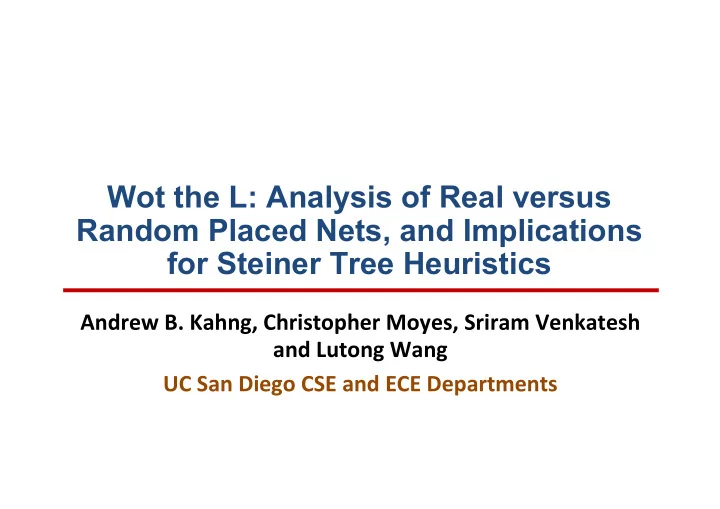

Wot the L: Analysis of Real versus Random Placed Nets, and Implications for Steiner Tree Heuristics Andrew B. Kahng, Christopher Moyes, Sriram Venkatesh and Lutong Wang UC San Diego CSE and ECE Departments
Outline • Background and Motivation • L-ness definition • Related Work • Pointset Characterization • Real Pointset Generator • Our New Lookup Table for RSMT Estimation • Conclusion 2
Background • RSMT Cost (Cheng 1994, Caldwell 1999 ) • Use AR and / or cardinality Estimators built using random pointsets. Tables from Caldwell et al. 1999 3
Non-Uniformity of Real Placements • Real placements • Pointsets from leon3mp and theia • Commercial P&R tool • Non-uniformity in X / Y directions separately • Three types of net • Type L • Type R • Type O 4
Non-Uniformity of Real Placements • Figure below: superposition of 3 distributions • Type L: most pins near the left boundary • Type R: most pins near the right boundary • Type O: most pins near boundaries • Non-uniform pin distribution #pins 5
L-ness • Given a pointset P • B(P): the bounding box of P • R(P): the area of the largest empty rectangles • Inside B(P) • Contain one corner of B(P) • No points inside R(P)/B(P) = L-ness • 6
Outline • Background and Motivation • Related Work • Pointset Characterization • Real Pointset Generator • Our New Lookup Table for RSMT Estimation • Conclusion 7
Related Works RSMT estimation using random pointsets • [Cheng94][Caldwell99]: RSMT cost depends on cardinality / aspect ratio of a pointset Spanning and Steiner Tree Constructions • [Alpert93]: Prim-Dijkstra’s Algorithm that “blends” Prim’s MST and Dijkstra’s SPT algorithms • [Ho90]: Algorithm for optimal edge-overlapping separable MSTs to obtain Steiner trees • [Chu08]: FLUTE to generate near-optimal WL Steiner trees using lookup tables Our work: • Propose L-ness attribute of a pointset • L-ness distinguishes real from random pointsets • New pointset generator to match real pointsets • New lookup table for RSMT cost estimation. 8
Outline • Background and Motivation • Related Work • Pointset Characterization • Real Pointset Generator • Our New Lookup Table for RSMT Estimation • Conclusion 9
L-ness in Real versus Random Pointsets • Distributions of L-ness (R(P)/B(P)) • 100K pointsets, cardinality p = {4,5,6,7} • Real pointsets from 7 design blocks, two academic and two commercial placers, two technology nodes • Significantly larger L-ness for real pointsets Random pointsets Real pointsets 10
Statistical Difference (1) • Bootstrapping with 95% confidence interval Academic and commercial placements 0.95 confidence interval lower/upper bound for random pointsets Real pointsets are significantly different than random pointsets! 11
Statistical Difference (2) • Two-sample Kolmogorov-Smirnov test • Statistically significant different when �� �� � �� � � � � ⋅ sup � � � � � p KS Statistic 3 3.363 x: R(P)/B(P) 4 3.788 F(x): cumulative distribution 5 5.159 for real pointsets G(x): cumulative distribution 6 4.461 for random pointsets 7 3.658 sup: maximum distance 10 4.754 12 7.106 All are greater than 1.36! 12
Outline • Background and Motivation • Related Work • Pointset Characterization • Real Pointset Generator • Our New Lookup Table for RSMT Estimation • Conclusion 13
Pointset Generation • Inputs: • cardinality � , Generate k points on • #points � on bbox, the bounding box = ( � � � ) points inside bbox • Target L-ness range � � � � � � � � � � � ∆ ��� , � � � � ∆ ��� � Add a point • Aspect ratio �� • Output: yes Delete • Pointset P � � � � � � � � � � � ∆ ��� last point � 100K pointsets generated using no distribution of � � � �, �, � � � , �� from Output � �� � real placements 14
Impact of L-ness on RSMT Heuristics (1) • Use 10K pointsets per each R(P)/B(P) • 0.2 � R�P�/B�P� � 0.8 • ���� � 0.1 • ∆ ��� � 0.02 • Evaluation: 4 RSMT heuristics • Rectilinear MST • Prim-Dijkstra (PD) [Alpert93] (with parameter α = 0.3, 1) • Optimal edge-overlapping PD Steiner trees (HVW) [Ho90] • FLUTE [Chu15] 15
Impact of L-ness on RSMT Heuristics (2) • Implications • Wirelength as L-ness • Difference in WL among heuristics as L-ness Assesments of heuristics’ benefits may have been misguided by the use of random pointsets 16
Outline • Background and Motivation • Related Work • Pointset Characterization • Real Pointset Generator • Our New Lookup Table for RSMT Estimation • Conclusion 17
Improved WL Estimation Lookup Table • Three parameters in lookup table: AR, R(P)/B(P), p • W1: oblivious to L-ness (equivalent to [Caldwell99]) • W2: our LUT • W3: %difference from W2 to W1 (1) [Caldwell99] (2) Ours � – � %diff = 100 ⋅ ��� 18
Advantages of Improved Lookup Table (1) • Accuracy �� ���� � �� ����� ⋅ 100% • Error = �� ����� • The entire lookup table is available: • http://vlsicad.ucsd.edu/~sriram/Final_WL_estimate_LUT.htm 19
Advantages of Improved Lookup Table (2) • Runtime: FLUTE, our LUT and RMST • 500k real and random pointsets • ~2X faster than RMST • ~10X faster than FLUTE In terms of speed and accuracy, this new LUT is a non-dominated wirelength estimator! 20
Outline • Background and Motivation • Related Work • Pointset Characterization • Real Pointset Generator • Our New Lookup Table for RSMT Estimation • Conclusion 21
Conclusion • Formal definition of L-ness • Characterization of real and random pointsets • Pointset generator to match real pointsets • Implication to RSMT heuristics • Improved lookup tables for RSMT cost estimation, considering L-ness • Accuracy and runtime comparison to previous works. • Ongoing and future works • Direct L-ness-aware placement • Better wirelength correlation with routing • Wot the L = Know the L 22
THANK YOU! 23
Recommend
More recommend